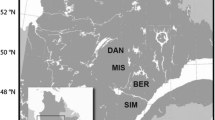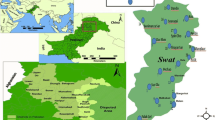Abstract
It is indisputable that cambium maturity contributes to the basic density of wood. It is shown that in the case of two independent Scots pine materials collected from Eastern Finland, the basic density depends solely on cambium age, while distance from the tree pith makes no contribution at all. It is also shown that the basic density is independent of growth rate, even if it is negatively correlated with annual ring width.







Similar content being viewed by others
References
Björklund L, Walfridsson E (1993) Tallvedens egenskaper i Sverige—Torr-rådensitet, kärnvedhalt, fuktighet och barkhalt. Properties of Scots pine wood in Sweden—basic density, heartwood, moisture and bark content. The Swedish University of Agricultural Sciences, Department of Forest Products, report 234, 75 p.
Dorn D (1968) Relationship of specific gravity and tracheid length to growth rate and provenance in Scotch pine. 16th northeastern forest tree improvement conference, Mcdonald College, Quebec, Canada, 8–10 August 1968, pp 1–6
Ericson B (1960) Studies of the genetical wood density variation in Scots Pine and Norway Spruce. Statens skogsforskningsinstitut, avdelningen för skogsproduktion, rapport 4. Forest Research Institute of Sweden, Department of Forest Yield Research, report 4, 52 p.
Hackett WP (1976) Control of phase change in woody plants. Acta Hort 56:143–154
Hakkila P (1967) Vaihtelumalleja kuoren painosta ja painoprosentista. Variation patterns of bark weight and bark percentage by weight. Comm Inst For Fenn 62(5):37 p.
Hartig R (1874) Das specifische Frisch- und Trockengewicht, der Wassergehalt und das Schwinden des Kiefernholzes. Z Forst Jagd 6:194–218
Hartig R (1885) Das Holz der deutschen Nadelwaldbäume. Verlag von Julius Springer, Berlin, 147 p.
Hiley WE (1955) Quality in softwoods. Q J Forest 49:159–164
Huikari O, Aitolahti M, Metsänheimo U, Veijalainen, P (1967) Puuston kasvumahdollisuuksista ojitetuilla soilla Pohjois-Suomessa. On the potential tree growth on drained peat lands in Northern Finland. Comm Inst For Fenn 64(5)
Longman KA, Wareing PF (1959) Early induction of flowering in birch seedlings. Nature 184(4704):2037–2038
Lundh E (1925) Produktionsundersökningar å avdikade marker inom Bjurfors Kronopark. Sv Skogsv för Tidskr 23:195–248, 315–348
Olesen PO (1978) On cyclophysis and topophysis. Silvae Genetica 27(5):173–178
Omeis E (1895) Untersuchungen des Wachsthumsganges und der Holzbeschaffenheit eines 110jährigen Kiefernbestandes. Forst Naturwiss Z 4(4):137–170
Rendle BJ, Phillips EWJ (1958) The effect of rate of growth (ring width) on the density of softwoods. Forestry 31(2):113–120
Robinson LW, Wareing PF (1969) Experiments on the juvenile-adult phase change in some woody species. New Phytol 68:67–78
Schwappach A (1892) Beiträge zur Kenntniss der Qualität des Kiefernholzes. Z Forst Jagd 14(1):75–88
Schwappach A (1897) Raumgewicht und Druckfestigkeit des Holzes wichtiger Waldbäume. 1. Die Kiefer. Verlag von Julius Springer, Berlin, pp 1–133
Seppälä K (1969) Kuusen ja männyn kasvun kehitys ojitetuilla turvemailla. Acta For Fenn 93
Sirviö J, Kärenlampi P (2000) The effects of maturity and growth rate on the properties of spruce wood tracheids. Wood Sci Technol 35(6):541–554
Uusvaara O (1974) Wood quality in plantation-grown Scots Pine. Comm Inst For Fenn 80(2):105 p.
Wareing PF, Frydman WM (1976) General aspects of phase change, with special reference to Hedera helix L. Acta Hort 56:57–69
Volkert E (1941) Untersuchungen über Grösse und Verteilung des Raumgewichts in Nadelholzstämmen. Schriftenreihe der Hermann-Göring-Akademie der Deutschen Forstwissenschaft 2:1–133
Yang KC, Hazenberg G (1994) Impact of spacing on tracheid length, relative density, and growth rate of juvenile wood and mature wood in Picea mariana. Can J Forest Res 24(5):996–1007
Acknowledgement
The authors highly appreciate the technical and financial assistance of their industrial collaborators, as well as the experimental assistance of Petri Hallikainen and Mika Tahvanainen.
Author information
Authors and Affiliations
Corresponding author
Rights and permissions
About this article
Cite this article
P. Kärenlampi, P., Riekkinen, M. Maturity and growth rate effects on Scots pine basic density. Wood Sci Technol 38, 465–473 (2004). https://doi.org/10.1007/s00226-004-0243-7
Received:
Published:
Issue Date:
DOI: https://doi.org/10.1007/s00226-004-0243-7




